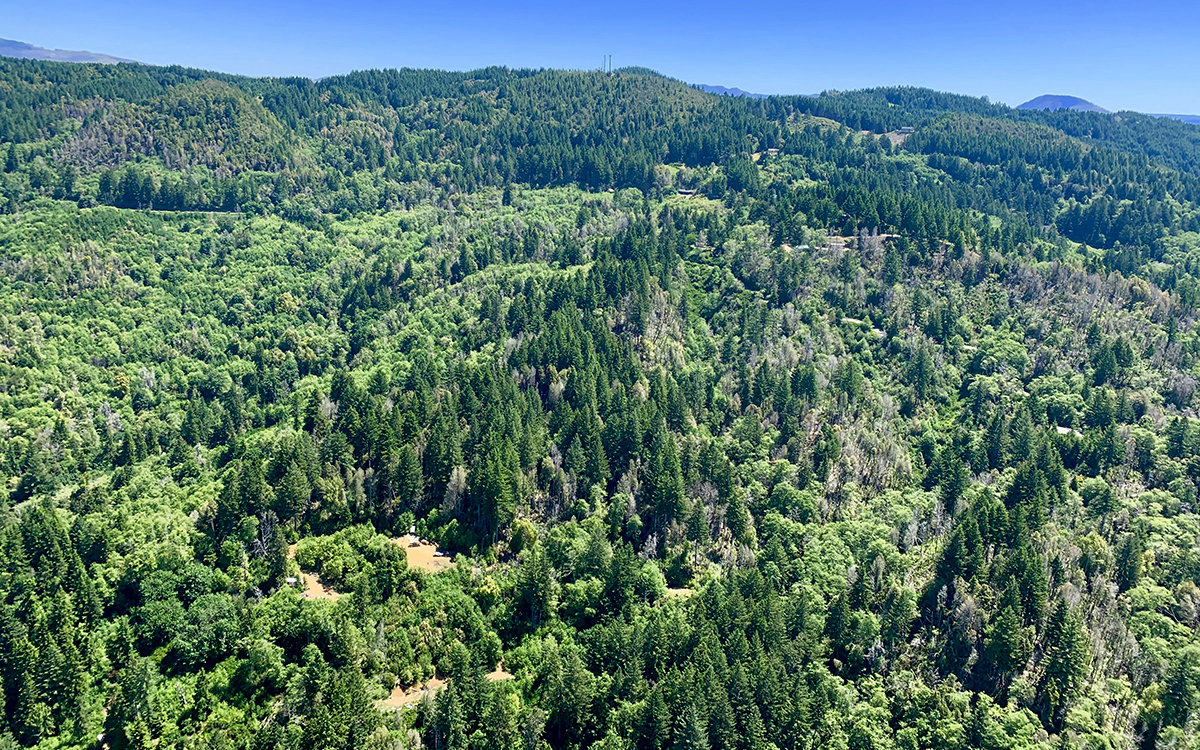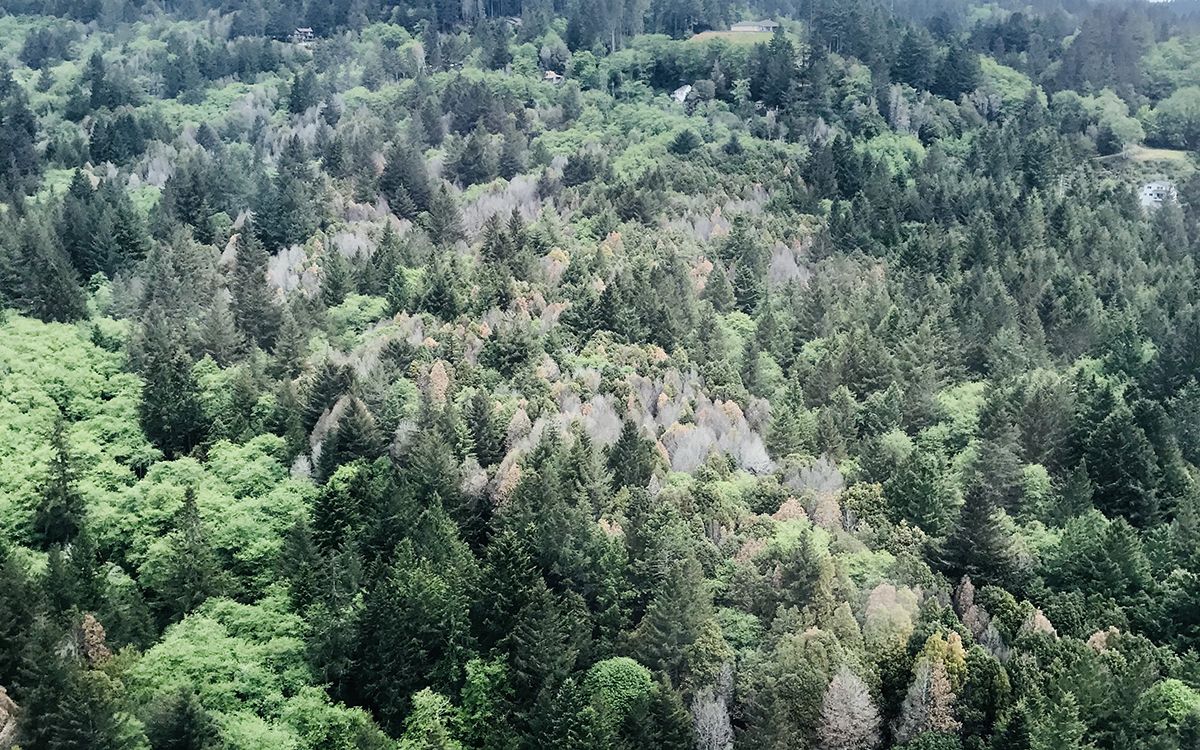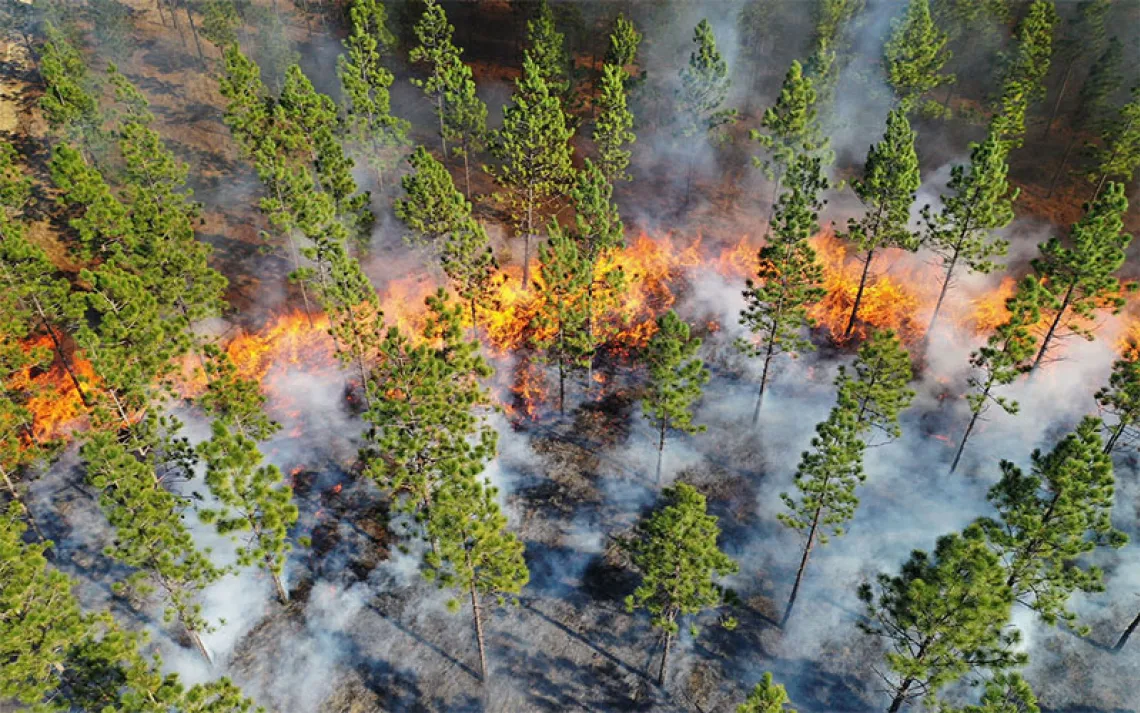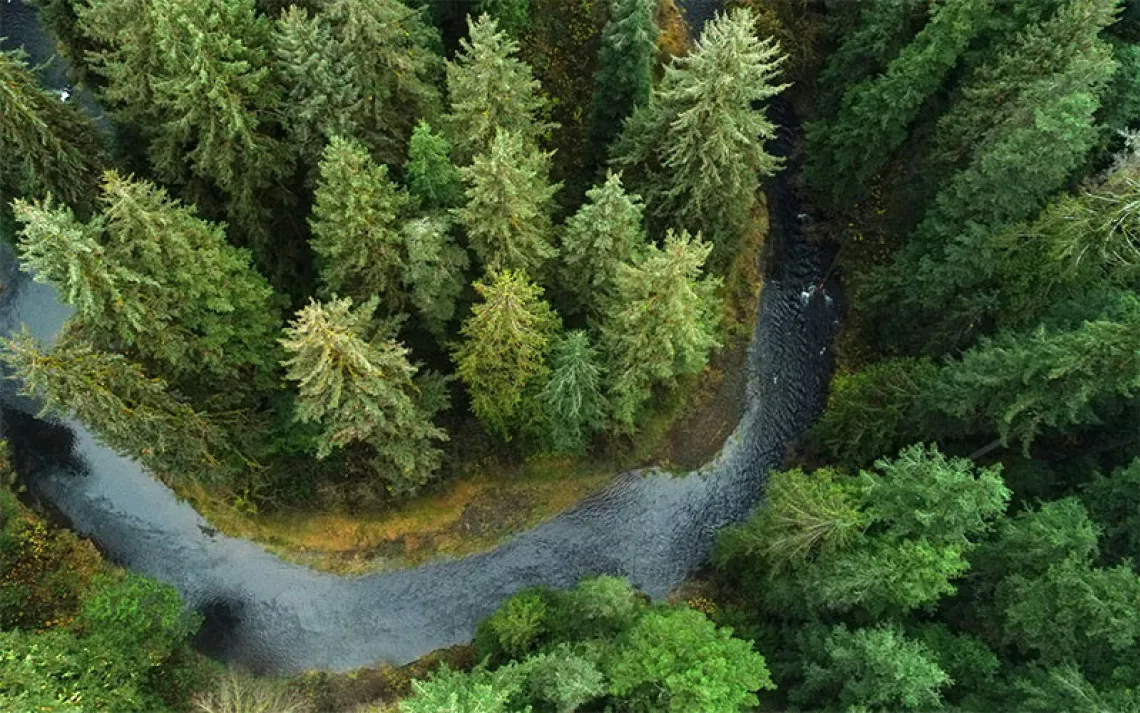A Quarantine in the Forest
Holding back a deadly epidemic in Oregon

A tanoak north of Brookings, Oregon, afflicted with sudden oak death. | Photo by Sarah Navarro, Oregon Department of Forestry
One day in the spring of 2001, Everett Hansen, a forest pathologist at Oregon State University, gazed up at a towering tanoak tree on a hillside north of the Chetco River and frowned.
Days earlier, a small, fixed-wing plane had marked the tree’s location as it flew up the southern Oregon coast, surveying for signs of dead and dying trees. A new and mysterious disease was ravaging California’s oak trees, and the plane was surveying the forest to establish a set of baseline images—a moment in time scientists could refer back to in case the disease did show up in Oregon.
But when Hansen examined the photos from the survey, a few clusters of trees made him suspicious.
 Photo by Sarah Navarro, Oregon Department of Forestry
Photo by Sarah Navarro, Oregon Department of Forestry
He and a group of scientists from the Oregon Department of Forestry, the Oregon Department of Agriculture, and the US Forest Service decided to follow up in person. They wandered through the forest for most of the morning and found the tanoak. Its trunk was covered in cankers bleeding black ooze. Sudden oak death had already arrived. “We came to the quick conclusion that if we were going to have any chance of stopping it, we had to act,” Hansen said. “We couldn’t wait until we understood.”
The scientists invoked a state law allowing them to quarantine nine square miles of forest near Brookings, where the Chetco meets the Pacific, and launched a scorched-earth campaign to eradicate the disease. They chopped the diseased trees down, along with a hundred-foot buffer of healthy trees and other plants that might harbor the disease. Then they burned everything.
Oregon’s quarantine law allowed them to move fast. But it also meant that they couldn’t leave even a single tree inside the quarantine area uncut as a control, to test if their intervention was working. It would be almost 20 years before Hansen and his colleagues had any idea how effective their treatments were.

Photo by Sarah Navarro, Oregon Department of Forestry
In the beginning, nobody knew what was causing sudden oak death. When David Rizzo, a professor of plant pathology at UC Davis, arrived in California in the mid-1990s, he didn’t think much of the patches of oak die-offs occurring up and down the coast. Back east, where he grew up, oaks went through periodic declines, usually associated with a period of drought that left them vulnerable to wood-boring insects and disease.
California had just come out of what at that point was its longest drought in history, and there was an increase in insects and disease. In a few years, Rizzo figured, it would stop. Still, said Rizzo, “There was always that nagging possibility that it was something else.”
Then, in the spring of 2000, oaks began to die throughout the San Francisco Bay Area. That June, Rizzo invited Hansen to examine ailing trees in Muir Woods National Monument. Rizzo went back to his lab with samples from the trees, and, working with a colleague, Matteo Garbelotto, came to a disturbing conclusion. The samples harbored a species of fungus new to North America. It didn’t have a name, but Rizzo knew enough to ID the fungus as a member of the genus Phytophthora.
Phytophthora is a combination of the ancient Greek “phytón,” or plant, and “phthorá,” which means to ruin or destroy. The literal translation was “plant destroyer.” The most famous phytophthora, P. infestans, is known throughout the world as potato blight and was partially responsible for the starvation of more than 1 million Irish in the mid-1800s.
Like other species in the genus, sudden oak death, or P. ramorum, is a water mold. More closely related to algae than true fungi, it produces tadpole-like spores that swim through films of water on leaves and branches in a tree’s canopy. Eventually, the spores wash down onto the tree’s trunk, where they eat through the tree's phloem (which ferries nutrients from the leaves to the rest of the tree) and cambium (which adds the new cells to the outer trunk that form the growth ring for each year), effectively girdling the tree from the inside out. By the time the disease’s tell-tale symptom—black, bleeding cankers—appear, the tree is near death but may have been infected for months. By the time the researchers in California began to understand the disease, sudden oak death had infected trees from Big Sur to Humboldt County.
At first, scientists studying sudden oak death had a hard time figuring out how it spread. It behaves differently in different locations, for reasons that remain unknown. In California, bay laurel is the disease’s primary host. In Oregon, it’s tanoak. In California, spores splash from tree to tree during heavy rains. In Oregon, the spores can travel up to two and a half miles in the fog that blows in from the Pacific.
When a stand of tanoak becomes infected, 99 percent of the trees in the stand die, said Jared LeBoldus, a plant pathologist at Oregon State University. Because the pathogen isn’t native to North America, trees haven’t had a chance to develop any immunity. Scientists aren’t positive how sudden oak death came to this country, but many think it hitched a ride to nurseries in Santa Cruz and Mill Valley on ornamental plants (probably rhododendron) from Southeast Asia.
Sudden oak death doesn’t limit itself to just oaks. Tanoak, which isn’t a true oak, is particularly susceptible. So are 150-some-odd plants common in both wildlands and the horticultural industry, including fir, larch, maple, and oak trees (the true kind, including coast live oak, canyon live oak, southern red oak, and California black oak), myrtles, madrones, manzanitas, rhododendrons, huckleberries, blackberries, and ferns. “If you walk through a redwood or oak forest in Northern California,” Rizzo said, “almost every tree you’re looking at is a host.”
Part of the reason it took so long to learn so little about sudden oak death is that few of the people in a position to establish a quarantine in the early days cared about tanoak. Tanoak acorns were a major food source for California Indian tribes, and its bark was used to tan leather until the early 1900s, but it has little economic value in a forest that is managed for logging. In the annals of tanoak biology, most of the literature is on how to kill it so you can grow douglas fir. “So when tanoak started to die, Rizzo said, “people were kind of like, ‘alright, why should we care?’”
The spread of botanical diseases around the world is a problem that continues to spiral outward. In the early 20th century, chestnut blight was accidentally imported to the United States on nursery plants from Southeast Asia. Within 50 years, chestnut was functionally extinct—saplings continue to grow but succumb to the disease before they reach maturity. Dutch elm disease, which arrived in the 1920s, extirpated the elms. Butternut canker, which began infecting trees in the 1970s, is wiping out the butternuts. The next outbreak could happen at any time, and the trade in exotic plants continues to be a vector. “Millions of plants are moved all over the world every year,” Rizzo said. The more scientists look for new diseases, the more they find. One recent review found at least 25 Phytophthora species had been unintentionally introduced into native plant restoration sites near natural ecosystems and parks in Northern California. “Please note,” the paper’s authors wrote, “that as this review is being written, more Phytophthora species are being discovered.”
According to a recent study published in the journal Forest Pathology, the cooperation among the four agencies in Oregon involved with combating sudden oak death, along with the speed at which they jumped to quarantine it, were crucial to slowing sudden oak death’s spread. “On the one hand, the likelihood of new trees being detected was much lower when we were able to treat the outbreak very quickly,” said Hansen, the paper’s lead author. “On the other, we put a lot of time and money into our effort, but the best we can show is that we’ve slowed the development of the disease.”
In 2012, the state changed the goal of its program from “eradication” to “slow the spread.” The agencies in charge of fighting the disease have expanded their quarantine area seven times (today, the line on the map is drawn around an area of more than 500 square miles). While sudden oak death has been contained to a single county, keeping it isolated within that county for as long as possible would cost more than $6 million a year. “It’s one thing if you can eradicate it, but it’s another thing if all you’re doing is slowing it down,” Hansen said. “In Oregon’s situation, it’s reinvigorated our determination to keep at it. We can value the benefits of slowing it down over the consequences of delaying.”
The fate of tanoak will probably be similar to that of chestnut, Hansen admitted. Many people may not even notice it’s disappeared from the California and Oregon coast. The forest will persist. It will just be made up of other, more resistant species.
But tanoak’s functional extinction has the potential to do a lot of unexpected damage. In a good season, a mature tanoak can produce 1,000 pounds of acorns. Mule deer, acorn woodpeckers, and northern flying squirrels are just a few of the animals that depend on them for food. The open forests created by tanoak provide critical habitat for Pacific giant salamanders, fishers, and dusky-footed woodrats (and, perhaps more important, the rat’s main predator: the northern spotted owl). If sudden oak death continues to spread unchecked, we won’t just lose tanoak but possibly all the species that depend on its existence.
 The Magazine of The Sierra Club
The Magazine of The Sierra Club



